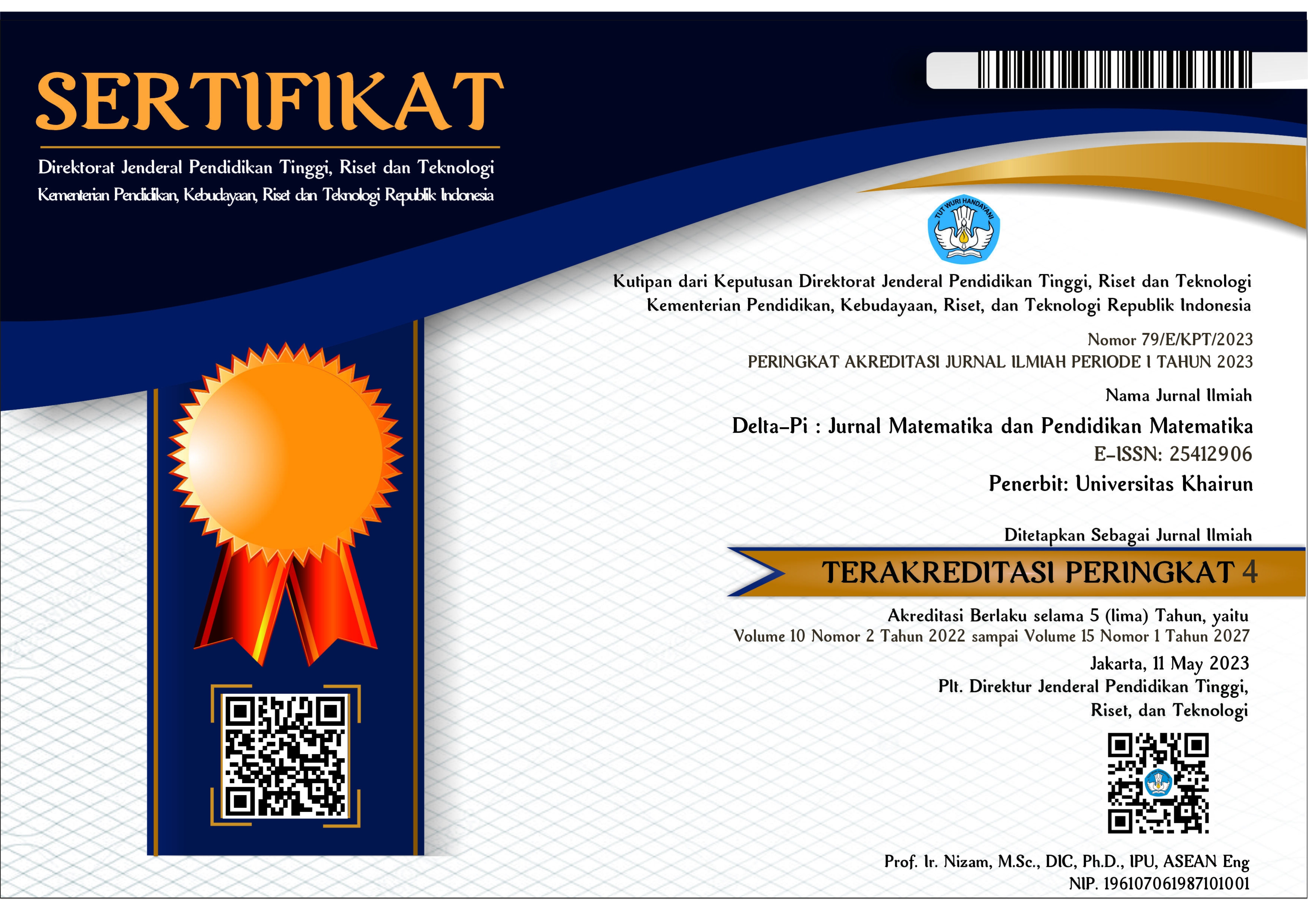Investigasi Kecemasan Siswa Sekolah Menengah Pertama Terhadap Representasi Matematis
Sari
Teks Lengkap:
PDFReferensi
Acharya, B. R. (2017). Factors affecting difficulties in learning mathematics by mathematics learners. International Journal of Elementary Education, 6(2), 8-15. http://www.ijoeedu.com/article/192/10.11648.j.ijeedu.20170602.11
Adam, A. M. (2020). Sample size determination in survey research. Journal of Scientific Research and Reports, 90-97. https://doi.org/10.9734/jsrr/2020/v26i530263
Ade, A., Mirza, A., & Sayu, S. (2018). Keefektifan Pembelajaran Model Eliciting Activities (Meas) Untuk Meningkatkan Kemampuan Representasi Matematis Dan Mengurangi Kecemasan Siswa. Jurnal Pendidikan dan Pembelajaran Khatulistiwa, 7(5), 1-9. https://jurnal.untan.ac.id/index.php/jpdpb/article/view/25609
Ahmad, S. R. (2016). Pengaruh math phobia, self-efficacy, adversity quotient dan motivasi berprestasi terhadap prestasi belajar matematika siswa SMP. Jurnal Riset Pendidikan Matematika, 3(2), 259-272. http://dx.doi.org/10.21831/jrpm.v3i2.6138
Anita, I. W. (2014). Pengaruh kecemasan matematika (mathematics anxiety) terhadap kemampuan koneksi matematis siswa SMP. Infinity Journal, 3(1), 125-132. https://doi.org/10.22460/infinity.v3i1.p125-132
Anwar, R. B., & Rahmawati, D. (2017). Symbolic and Verbal Representation Process of Student in Solving Mathematics Problem Based Polya's Stages. International Education Studies, 10(10), 20-28. https://eric.ed.gov/?id=EJ1156292
Apuke, O. D. (2017). Quantitative research methods: A synopsis approach. Kuwait Chapter of Arabian Journal of Business and Management Review, 33(5471), 1-8. https://platform.almanhal.com/Files/Articles/107965
Ashcraft, M. H. (2019). Models of math anxiety. In Mathematics Anxiety (pp. 1-19). Routledge. https://www.taylorfrancis.com/chapters/edit/10.4324/9780429199981-1/models-math-anxiety-mark-ashcraft
Athallah, P. F., & Roesdiana, L. (2021). Studi Kasus Kemampuan Representasi Matematis Siswa pada Kelas IX SMP Negeri 2 Telukjambe Timur Kabupaten Karawang. Delta-Pi: Jurnal Matematika dan Pendidikan Matematika, 10(1). http://dx.doi.org/10.33387/dpi.v10i1.2713
Auliya, R. N. (2016). Kecemasan matematika dan pemahaman matematis. Formatif: Jurnal Ilmiah Pendidikan MIPA, 6(1). http://dx.doi.org/10.30998/formatif.v6i1.748
Bochner, S. (2014). Role of Mathematics in the Rise of Science. Princeton University Press.
Clayton, S., & Karazsia, B. T. (2020). Development and validation of a measure of climate change anxiety. Journal of Environmental Psychology, 69, 101434. https://doi.org/10.1016/j.jenvp.2020.101434
Dowker, A., Sarkar, A., & Looi, C. Y. (2016). Mathematics anxiety: What have we learned in 60 years?. Frontiers in psychology, 7, 508. https://doi.org/10.3389/fpsyg.2016.00508
Everingham, Y. L., Gyuris, E., & Connolly, S. R. (2017). Enhancing student engagement to positively impact mathematics anxiety, confidence and achievement for interdisciplinary science subjects. International Journal of Mathematical Education in Science and Technology, 48(8), 1153-1165. https://doi.org/10.1080/0020739X.2017.1305130
Ernest, P. (2018). The ethics of mathematics: is mathematics harmful?. In The philosophy of mathematics education today (pp. 187-216). Springer, Cham. https://doi.org/10.1007/978-3-319-77760-3_12
Gabriel, F., Buckley, S., & Barthakur, A. (2020). The impact of mathematics anxiety on self-regulated learning and mathematical literacy. Australian Journal of Education, 64(3), 227-242. https://doi.org/10.1177/0004944120947881
Habibah, A. N., Anita, N., Fitayanti, N., & Rahmawati, A. (2020). Representasi Matematis dalam Memecahkan Masalah Matematika Berdasarkan Tingkat IQ dan Kecemasan Matematika. In Prosiding SI MaNIs (Seminar Nasional Integrasi Matematika dan Nilai-Nilai Islami) (Vol. 3, No. 1, pp. 144-151). http://conferences.uin-malang.ac.id/index.php/SIMANIS/article/view/926
Hafni, R. N., Herman, T., Nurlaelah, E., & Mustikasari, L. (2020, March). The importance of science, technology, engineering, and mathematics (STEM) education to enhance students’ critical thinking skill in facing the industry 4.0. In Journal of Physics: Conference Series (Vol. 1521, No. 4, p. 042040). IOP Publishing. https://doi.org/10.1088/1742-6596/1521/4/042040/meta
Hasibuan, C. F. (2020). The measurement of customer satisfaction towards the service quality at xyz wholesale by using fuzzy service quality method. In IOP Conference Series: Materials Science and Engineering (Vol. 909, No. 1, p. 012053). IOP Publishing. http://dx.doi.org/10.1088/1757-899X/909/1/012053/meta
Hidayat, R. (2018). Kontribusi mathematics anxiety terhadap kemampuan akademik mahasiswa pada pembelajaran kalkulus. JNPM (Jurnal Nasional Pendidikan Matematika), 2(2), 206-216. http://dx.doi.org/10.33603/jnpm.v2i2.847
Huang, X., Zhang, J., & Hudson, L. (2019). Impact of math self-efficacy, math anxiety, and growth mindset on math and science career interest for middle school students: the gender moderating effect. European Journal of Psychology of Education, 34(3), 621-640. https://doi.org/10.1007/s10212-018-0403-z
Imro’ah, S., Winarso, W., & Baskoro, E. P. (2019). Analisis Gender Terhadap Kecemasan Matematika Dan Self Efficacy Siswa. Kalamatika: Jurnal Pendidikan Matematika, 4(1), 23-36. https://doi.org/10.22236/KALAMATIKA.vol4no1.2019pp23-36
Justiciaâ€Galiano, M. J., MartÃnâ€Puga, M. E., Linares, R., & Pelegrina, S. (2017). Math anxiety and math performance in children: The mediating roles of working memory and math selfâ€concept. British Journal of Educational Psychology, 87(4), 573-589. https://doi.org/10.1111/bjep.12165
Khoshaim, H. B. (2020). Mathematics Teaching Using Word-Problems: Is It a Phobia!. International Journal of Instruction, 13(1), 855-868. https://eric.ed.gov/?id=EJ1239298
Kusumawati, A. F. (2017). Pengaruh Pembelajaran Matematika Melalui Strategi React Dengan Pendekatan Open-Ended Terhadap Kemampuan Representasi Matematis Dan Kecemasan Matematika Siswa Smk Di Kota Bandung (Doctoral dissertation, FKIP Unpas). http://repository.unpas.ac.id/id/eprint/30400
Kyttala, M., & Bjorn, P. M. (2014). The role of literacy skills in adolescents' mathematics word problem performance: Controlling for visuo-spatial ability and mathematics anxiety. Learning and Individual Differences, 29, 59-66. https://doi.org/10.1016/j.lindif.2013.10.010
Lyons, I. M., & Beilock, S. L. (2012). Mathematics anxiety: Separating the math from the anxiety. Cerebral cortex, 22(9), 2102-2110. https://doi.org/10.1093/cercor/bhr289
Muri’ah, D. H. S., & Wardan, K. (2020). Psikologi Perkembangan Anak dan Remaja. Literasi Nusantara.
Mutlu, Y. (2019). Math Anxiety in Students with and without Math Learning Difficulties. International Electronic Journal of Elementary Education, 11(5), 471-475. https://eric.ed.gov/?id=EJ1222170
Muzaini, M., Hasbi, M., & Nasrun, N. (2021). The Role of Students’ Quantitative Reasoning in Solving Mathematical Problems Based on Cognitive Style. Vygotsky: Jurnal Pendidikan Matematika dan Matematika, 3(2), 87-98. https://doi.org/10.30736/voj.v3i2.380
National Research Council. (2013). The mathematical sciences in 2025. National Academies Press.
Novitasari, P., Usodo, B., & Fitriana, L. (2021). Visual, Symbolic, and Verbal Mathematics Representation Abilities in Junior High School’s Students. In Journal of Physics: Conference Series (Vol. 1808, No. 1, p. 012046). IOP Publishing. https://doi.org/10.1088/1742-6596/1808/1/012046/meta
Perini, N., Sella, F., & Blakey, E. (2020). Developmental dyscalculia: Signs and symptoms. In Understanding Dyscalculia (pp. 23-40). Routledge. https://www.taylorfrancis.com/chapters/edit/10.4324/9780429423581-3/developmental-dyscalculia-nicoletta-perini-francesco-sella-emma-blakey
Pizzie, R. G., & Kraemer, D. J. (2017). Avoiding math on a rapid timescale: Emotional responsivity and anxious attention in math anxiety. Brain and Cognition, 118, 100-107. https://doi.org/10.1016/j.bandc.2017.08.004
Pratiwi, R., Coesamin, M., & Widyastuti, W. (2017). Penerapan Pembelajaran Kontekstual untuk Meningkatkan Kemampuan Representasi Matematis Siswa. Jurnal Pendidikan Matematika Universitas Lampung, 5(4). http://jurnal.fkip.unila.ac.id/index.php/MTK/article/view/12912
Primi, C., Busdraghi, C., Tomasetto, C., Morsanyi, K., & Chiesi, F. (2014). Measuring math anxiety in Italian college and high school students: validity, reliability and gender invariance of the Abbreviated Math Anxiety Scale (AMAS). Learning and Individual Differences, 34, 51-56. https://doi.org/10.1016/j.lindif.2014.05.012
Priyanto, D. (2017). Tingkat dan faktor kecemasan matematika pada siswa Sekolah Menengah Pertama. Jurnal Pendidikan dan Pembelajaran Khatulistiwa, 6(10). https://jurnal.untan.ac.id/index.php/jpdpb/article/view/22105
Qausarina, H. (2016). Pengaruh kecemasan matematika (math anxiety) terhadap hasil belajar matematika siswa kelas X SMA Negeri 11 Banda Aceh (UIN Ar-Raniry Banda Aceh). https://core.ac.uk/download/pdf/293465511.pdf
Ramirez, G., Gunderson, E. A., Levine, S. C., & Beilock, S. L. (2013). Math anxiety, working memory, and math achievement in early elementary school. Journal of Cognition and Development, 14(2), 187-202. https://doi.org/10.1080/15248372.2012.664593
Sahendra, A., Budiarto, M. T., & Fuad, Y. (2018). Students’ representation in mathematical word problem-solving: exploring students’ self-efficacy. In Journal of Physics: Conference Series (Vol. 947, No. 1, p. 012059). IOP Publishing. https://doi.org/10.1088/1742-6596/947/1/012059/meta
Sakarti, H. (2018). Hubungan kecemasan dan kemampuan siswa dalam menyelesaikan masalah matematika. Jurnal Pendidikan Informatika dan Sains, 7(1), 28-41. http://www.journal.ikippgriptk.ac.id/index.php/saintek/article/view/766
Sanjaya, I. I., Maharani, H. R., & Basir, M. A. (2018). Kemampuan Representasi Matematis Siswa pada Materi Lingkaran Berdasar Gaya Belajar Honey Mumfrod. Kontinu: Jurnal Penelitian Didaktik Matematika, 2(1), 72-87. http://dx.doi.org/10.30659/kontinu.2.1.72-87
Sari, D. P. (2018). Errors of Students Learning with React Strategy in Solving the Problems of Mathematical Representation Ability. Journal on Mathematics Education, 9(1), 121-128. https://eric.ed.gov/?id=EJ1173659
Sharma, R. R. (2019). Evolving a model of sustainable leadership: An ex-post facto research. Vision, 23(2), 152-169. https://doi.org/10.1177/0972262919840216
Siswono, T. Y. E. (2016). Berpikir Kritis dan Berpikir Kreatif sebagai Fokus Pembelajaran Matematika. In Seminar Nasional Matematika dan Pendidikan Matematika (pp. 11-26).
Stephan, M., Register, J., Reinke, L., Robinson, C., Pugalenthi, P., & Pugalee, D. (2021). People use math as a weapon: critical mathematics consciousness in the time of COVID-19. Educational Studies in Mathematics, 1-20. https://doi.org/10.1007/s10649-021-10062-z
Sulistiani, E., & Masrukan, M. (2017). Pentingnya berpikir kritis dalam pembelajaran matematika untuk menghadapi tantangan MEA. In PRISMA, Prosiding Seminar Nasional Matematika (pp. 605-612). https://journal.unnes.ac.id/sju/index.php/prisma/article/view/21554
Sumarni, W., & Kadarwati, S. (2020). Ethno-STEM project-based learning: Its impact to Critical and creative thinking skills. Jurnal Pendidikan IPA Indonesia, 9(1), 11-21. https://doi.org/10.15294/jpii.v9i1.21754
Tri, N. M., Hoang, P. D., & Dung, N. T. (2021). Impact of the industrial revolution 4.0 on higher education in Vietnam: challenges and opportunities. Linguistics and Culture Review, 5(S3), 1-15. https://doi.org/10.37028/lingcure.v5nS3.1350
Vukovic, R. K., Kieffer, M. J., Bailey, S. P., & Harari, R. R. (2013). Mathematics anxiety in young children: Concurrent and longitudinal associations with mathematical performance. Contemporary educational psychology, 38(1), 1-10. https://doi.org/10.1016/j.cedpsych.2012.09.001
Wibawa, S. (2018). Pendidikan dalam era revolusi industri 4.0. Indonesia. Yogyakarta: UST Yogyakarta.
Widjajanti, D. B. (2020). Mathematics learning based on multiple intelligences with scientific approaches: How are their roles in improving mathematical literacy skills?. In Journal of Physics: Conference Series (Vol. 1581, No. 1, p. 012040). IOP Publishing. https://doi.org/10.1088/1742-6596/1581/1/012040/meta
Widiati, I. (2015). Mengembangkan kemampuan representasi matematis siswa sekolah menengah pertama melalui pembelajaran kontekstual. Jurnal Pengajaran MIPA, 20(2), 106-111.
Widodo, S. A., Laelasari, L., Sari, R. M., Nur, I. R. D., & Putrianti, F. G. (2017). Analisis faktor tingkat kecemasan, motivasi dan prestasi belajar mahasiswa. Taman Cendekia: Jurnal Pendidikan Ke-Sd-An, 1(1), 67-77. https://doi.org/10.30738/tc.v1i1.1581
Widoyoko, E. P. (2012). Evaluasi program pembelajaran. Yogyakarta: pustaka pelajar.
Yaratan, H., & Kasapoğlu, L. (2012). Eighth grade students’ attitude, anxiety, and achievement pertaining to mathematics lessons. Procedia-Social and Behavioral Sciences, 46, 162-171. https://doi.org/10.1016/j.sbspro.2012.05.087
Zakaria, E., Zain, N. M., Ahmad, N. A., & Erlina, A. (2012). Mathematics anxiety and achievement among secondary school students. American Journal of Applied Sciences, 9(11), 1828. https://doi.org/10.3844/ajassp.2012.1828.1832
Zhou, D., Du, X., Hau, K. T., Luo, H., Feng, P., & Liu, J. (2020). Teacher-student relationship and mathematical problem-solving ability: mediating roles of self-efficacy and mathematical anxiety. Educational Psychology, 40(4), 473-489. https://doi.org/10.1080/01443410.2019.1696947
Refbacks
- Saat ini tidak ada refbacks.















